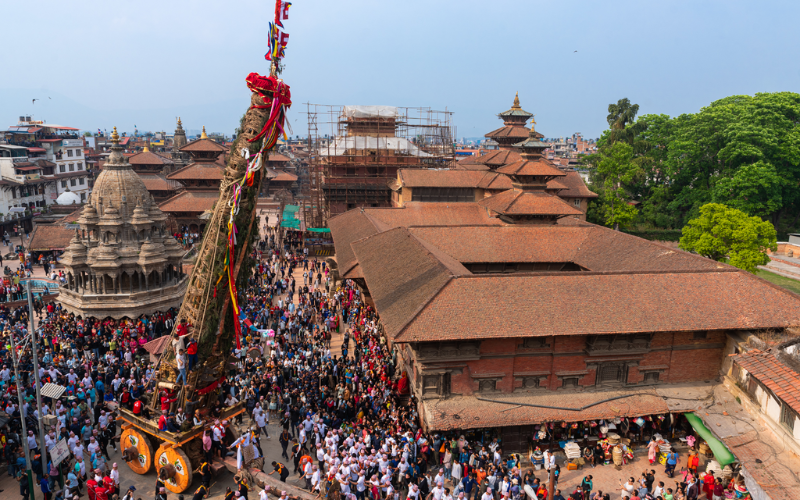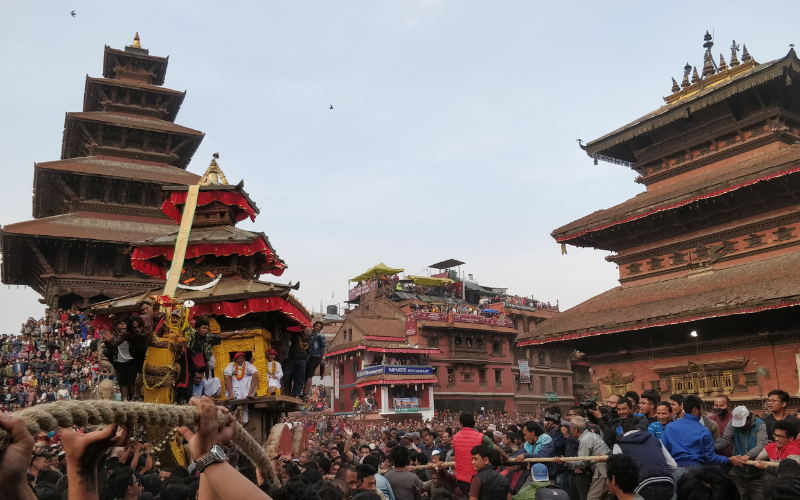Nepal is a country where traditions are not preserved behind glass—they unfold in the streets, in chariots pulled by thousands, in masked dances, and in rituals that have survived for centuries. Nowhere is this living heritage more powerful than in the jatras of the Kathmandu Valley, especially within the indigenous Newar community.
These festivals blend religion, community, seasonal cycles, and mythology in ways found nowhere else. Here are Nepal’s most iconic and culturally significant jatras—each one a unique encounter with history and devotion.
Indra Jatra – Kathmandu’s Iconic Festival of Dance, Lights & the Living Goddess
When: Usually August–September (dates vary by lunar calendar)
Where: Kathmandu Durbar Square and surrounding areas
Indra Jatra is one of the grandest festivals of Kathmandu. It honors Indra, the Hindu god of rain and the heavens, and incorporates a rich mix of Buddhist and Newar traditions.
A famous local myth tells of Indra descending to earth in search of a sacred flower and being captured by locals—though scholars also view the festival as a much older seasonal celebration that predates the myth.
What you’ll experience:
Chariot procession of Kumari, the Living Goddess
Masked dances, including the famous Lakhey dance
The raising of the Yosin/Linga, a tall ceremonial pole
Nighttime processions with lights and devotional music
Indra Jatra transforms Kathmandu into a moving theater of tradition.
Rato Machindranath Jatra – Patan’s Long and Legendary Chariot Procession
When: Typically April–June (timing shifts yearly)
Where: Patan (Lalitpur)
Dedicated to Rato Machindranath—also known as Bunga Dyah or Karunamaya—this jatra is one of the longest and most elaborate chariot festivals of the Kathmandu Valley. The deity is revered as a bringer of rain and a symbol of compassion.
A towering wooden chariot, often around 60 feet high, is constructed by skilled artisans and pulled through the narrow streets of Patan along a traditional route.

Key highlights:
The massive hand-pulled chariot, one of Nepal’s tallest
A route that winds from Pulchowk to Jawalakhel
Bhoto Jatra, the finale where a sacred vest (bhoto) is publicly displayed
This jatra is a spectacular demonstration of devotion, craftsmanship, and communal energy.
Biska Jatra – Bhaktapur’s Dramatic New Year Tradition
When: Mid-April (around Nepali New Year)
Where: Bhaktapur, Thimi, and Bode
Biska Jatra (often spelled Bisket Jatra) marks one of Bhaktapur’s most important annual celebrations. Though it coincides with the Nepali New Year, its origins lie in ancient Newar seasonal rituals.
The festival is known for its powerful chariot processions of Bhairava and Bhadrakali, and for the dramatic pulling down of a large ceremonial pole—a ritual full of symbolic meaning.

Highlights:
Chariots pulled through Bhaktapur’s narrow streets
Energetic tug-of-war between city sections to direct the chariot
The raising and lowering of the Yosin/Linga
Lively celebrations in nearby Thimi and tongue-piercing rituals in Bode
Biska Jatra is both visually overwhelming and culturally profound.
Gai Jatra – A Celebration of Memory and Community
When: August–September (Bhadra month)
Where: Kathmandu Valley
Gai Jatra, the “Cow Festival,” is one of Nepal’s most emotionally complex celebrations. Families who lost a relative in the past year take part in processions, historically with a cow—believed to guide the soul of the deceased. In modern times, children often dress as cows to represent this symbolism.
The festival also includes satire, humor, and performances—a centuries-old way of easing grief and strengthening community bonds.

You’ll see:
Costumed children representing the sacred cow
Musical and comedic street performances
Local groups presenting satire, a long-held tradition
Gai Jatra is a touching blend of remembrance, resilience, and communal healing.
Seto Machindranath Jatra – Kathmandu’s White Chariot Festival
When: Usually March–April
Where: Kathmandu city center
Separate from the Rato Machindranath festival of Patan, Seto Machindranath (the White Machindranath) is honored with a three-day chariot procession through the heart of old Kathmandu.
The deity, considered a manifestation of Avalokiteshvara, is believed to grant longevity and peace.

Key moments:
A beautifully crafted wooden chariot
A procession that visits Ason, Indra Chowk, and Hanuman Dhoka
Devotees offering prayers for blessings and wellbeing
This is one of Kathmandu’s most serene yet deeply symbolic jatras.
Ghode Jatra – Kathmandu’s Festival of Horses
When: March–April
Where: Tudikhel, Kathmandu
Ghode Jatra, the “Horse Festival,” features equestrian performances conducted primarily by the Nepal Army. It is believed to have originated as a ritual to ward off evil spirits—specifically a notorious demon linked to ancient Kathmandu legends.

Experience includes:
Horse races and acrobatics by military riders
Public gatherings at Tudikhel
Rituals honoring local protective deities
It is one of the most anticipated public displays in the capital.
Nepal’s jatras are not just festivals—they are dynamic expressions of history, belief, community identity, and artistic legacy. Each jatra offers a window into rituals passed down for generations, making them essential experiences for anyone wishing to understand Nepal’s cultural heart.
PC: Wikimedia Commons, Bijay Chaurasia
Also Read